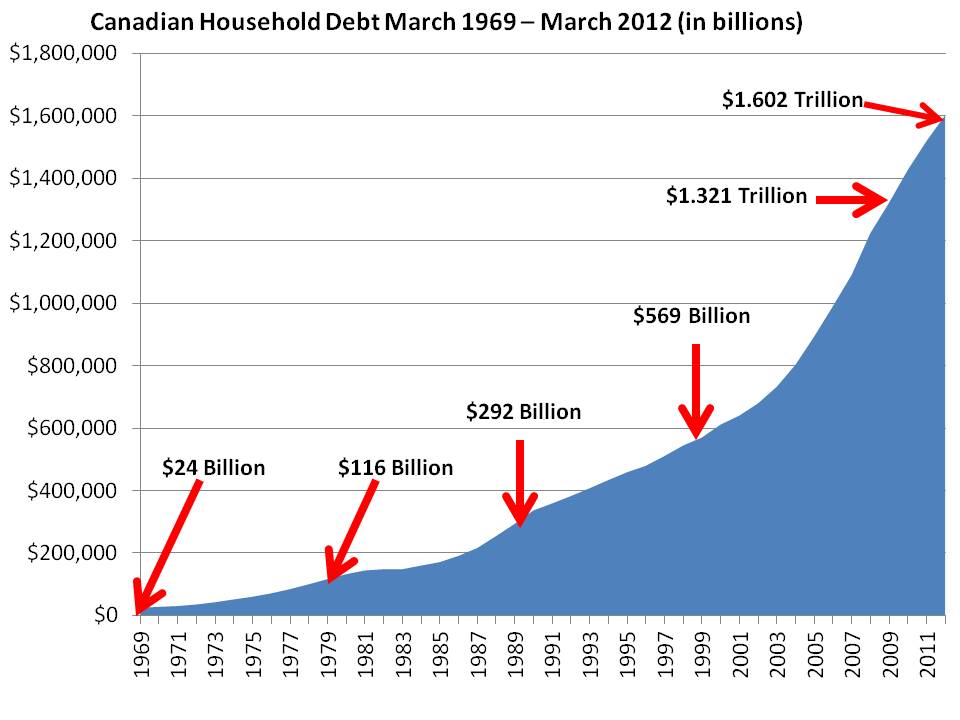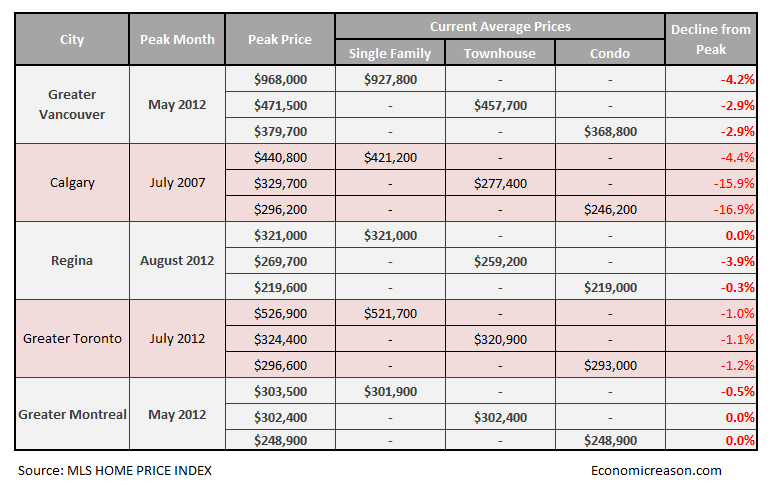Recent Canadian real estate data shows that the housing market has cooled; however, the much needed correction of valuation is far from over. Overall the housing correction was felt the most in Calgary; cities less affected were Regina and Montreal. Take a look below for average price statistics:
Canada’s Housing Price Statistics
Besides Calgary, the decline in housing prices in major Canada cities are not significant. Nevertheless, this seemingly insignificant may be a starting point to an upcoming larger decline. The current Canadian real estate bubble can best be analogized with a Ponzi scheme. Although Ponzi schemes are notorious for security investments (think Bernie Madoff), in this case it can also be associated with real estate: the real estate market is fuelled by perpetually new debt. This debt is fuelled by additional people entering into the market to the increase total national mortgage debt and consequently home prices increase.
Let me explain.
When purchasing real estate, the buyer generally borrows what he cannot put up front. The pricing of real estate is therefore subject to financing of a paper mortgage asset of a physical building. Take away the mortgage market and real estate prices will crash. If prices were based solely on real savings in a bank, then this would be a very different context. However, we must rely on debt and loan terms to purchase real estate, and this has a price that either attracts or repels potential buyers.
Here is the problem…
If the majority of people need to use debt, then debt becomes the driving force to higher prices, not savings. As people need to go further and further into mortgage debt, this continually drives up home prices. In other words, if total mortgage debt is not expanding, it is contracting. There is no in-between, because ‘in-between’ causes bankruptcies and reduces total mortgage debt. This is simple to understand if you understand that when a mortgage is created, debt is created. (See here how banks in Canada create money). When interest rates are raised or if terms are increased, this reduces the number of people available to purchase real estate; this can be a good thing, as it will force people to save until they have enough money for a sufficiently suitable down deposit. However, this is not favourable for banks as there bottom line will suffer.
A decrease in the number of people available to purchase real estate will lead to less total mortgage debt and the Ponzi debt scheme will come crashing down. Defaults will start spreading and banking activity will be halted, which further exacerbates the problem.
The Artificial Demand in Real Estate
The Canadian real estate market is heavily distorted (as the US market was prior to their crash). Prices need to come down to more realistic levels. If we consider single-family homes for what they are (homes provide shelter for survival), we see how ridiculous the greed of the past decade as been as people have misinterpreted their homes for ATM machines; further, it is in the greater good that real estate be affordable to everyone–and that can only be achieved if single-family homes are not packaged as attractive investment opportunities.
Imbalances in the market create advantages to people who are already leveraged in the real estate sector. This is why real-estate is such a heavily subsidized investment vehicle today. For instance, mortgage interest on rental properties can be deducted on income, there are zero capital gains tax in a primary residence and first-time home buyers credit, and even low down deposits can be granted in exchange for an CMHC insurance premium. (For the full explanation as to why people invest in real estate, read here.) These are all conditions the Canadian government created to entice people to invest into real estate–and this is NOT a free market environment. Therefore, creating artificial demand for real estate is the primary reason pushing home prices up along with debt levels.
The primary beneficiaries of this housing boom from the artificial demand are the banks! The secondary beneficiaries are eeal-estate development and construction companies. It is no wonder why the majority of bank assets are in mortgage lending–there is something tangible for them to acquire in the face of a default: “Cant pay your mortgage? Fine–but we will keep your house!” On the flip side, lending to companies generally poses a greater risk–especially to smaller companies (the real driving force of an economy)–as these companies usually set up legal entities that protect themselves with limited liability, thus rendering it much harder for a bank to possess the company’s assets in the event of default. Larger corporations do not have this problem as they have other sources of financing (stock market, private placement, bonds etc.). This scheme was carried out in the name of promoting affordable housing–how ironic.
CHMC employees are passionate about helping Canadians in need through promoting housing affordability and choice; are dedicated to facilitating access to more affordable, better quality housing for all Canadians by promoting the availability of low-cost financing.
Debt Crisis
When a mortgage is created, debt is created. And debt is the primary consequence of providing the subsidies mentioned above. More debt equals higher home prices. Yet, without the majority of people knowing it, when a mortgage is created, the money supply is increased and consequently inflation becomes possible. If money were actually taken from reserves, this would not happen; it would only be a transfer of cash. In our modern day fractional reserve banking system, the money is coming from the lost purchasing power of people who save. Debt crises are happening all over the world and this can not continue forever, as we live in a world with finite resources that cannot be printed up.
The money supply is critical to the health of a modern “creditopia” economy (phrase coined by Richard Duncan, author of The New Depression). If a lid is put on credit expansion, there will also be a limit to economic growth. We have grown addicted to credit, and now credit accounts for approximately 97% of all money. (Hard cash is about 3% of all money). In essence, since credit drives the economy and mortgage debt accounts for the majority of bank balance sheets, mortgage debt must increase further and further to maintain stability in Canada’s housing bubble and keep up growth in the economy. This is one of the main reason why our governments must increase the debt ceiling continuously and why interest rates are suppressed to near zero.
 Instead of experiencing a normal, healthy correction, central banks prop up our economy by lowering the interest rates for additional debt to be accumulated. However, this method is ruinous to any economy in the long run, and will only postpone a larger, inevitable decline.
Instead of experiencing a normal, healthy correction, central banks prop up our economy by lowering the interest rates for additional debt to be accumulated. However, this method is ruinous to any economy in the long run, and will only postpone a larger, inevitable decline.
At the moment, Canadian real estate is sustained by artificial stimuli, and once the ‘drug addict’ (the artificially-stimulated economy) decides to be free and clear, it will suffer a major downer (economic recession/depression). However this downer is essential for getting back to a functional and feasible economy where the malinvestments and market inefficiencies are liquidated.
Any ‘suffering’ created by a credit reduction is the consequence of the initial expansion, brought on by the incentives mentioned above. We must go through it to eliminate the inefficiencies and malinvestments made by the errors of misguided entrepreneurs, albeit an error promoted by the government itself. Canadians are in debt levels far beyond those of Americans before their housing correction. For more insightful truth on the Canadian banking sector, see our article here.
Yet, we should not hold our breath for this necessary correction, as deflation from the credit contraction is political suicide for those in government. Our government will most likely continue to prop up the economy and print the necessary money until hyperinflation sets in–and hyperinflation is but another form of depression. Unlike the American dollar, the Canada dollar is not the reserve currency, and thus it does not have the ‘luxury’ of printing money to oblivion.
Hyperinflation is not particularly good for real estate. A noteworthy example of hyper-inflation occurred in (and killed) the Weimar Republic (now Germany). Hyperinflation in the 1920s wiped out the country’s pre-inflation federal debt. To illustrate this clearly, the total balance of all mortgages across Germany in 1913 totalled approximately 40 billion marks (approximately $221 billion today). In 1913, this amount was roughly 16% of all German wealth. In 1923, ten years later, this amount was worth less than one American cent.
Canada’s Real-Estate Bubble is No Different From the Rest of the World
More debt, higher taxes to pay for the debt, and more unemployment cannot be good for people owning real estate in Canada, as real-estate is a function of jobs and income. As people lose their jobs and incomes, they will default on their mortgages or not pay rent. One possibility for landowners of income property is tougher rental board rules: tenant eviction, for instance, could potentially be made much tougher in the future, thus leaving landlords with reduced rental income or non-paying tenants.
If you are still not convinced that this is bad, what about the higher property taxes you will be faced from a desperate government wanting to pay for its bills? Or increased utility bills from the resulting inflation that our government is creating? Or the resulting increased insurance premiums? What about the increased property vandalism from tenants or from theft from increased poverty?
At a time of a global debt problem, the cure is to reduce debt and return to sound economic principles and not to increase debt, taxes, and regulations. This is NOT GOOD FOR REAL-ESTATE! And we have not even discussed the accompanying monetary policies (higher interest rates and regulations).
Higher interest rates cannot remain suppressed this low forever. And the longer they are suppressed, the more mal-investments are created and the harder the bust will be.
Since the Canadian economy is heavily dependent on the American economy, once they suffer their next crisis, Canada might not be too lucky this time in saving the real estate market as they did in 2008-2009. As proclaimed billionaire investor and contrarian, Jim Rogers, warned: “watch out for 2013-2014, the US is accustomed to a recession about every six years.”
If you enjoyed reading this article or for regular updates on the Canadian housing bubble statistics every month, you can receive this automatically by email by subscribing here.
Post your thoughts and questions below.



